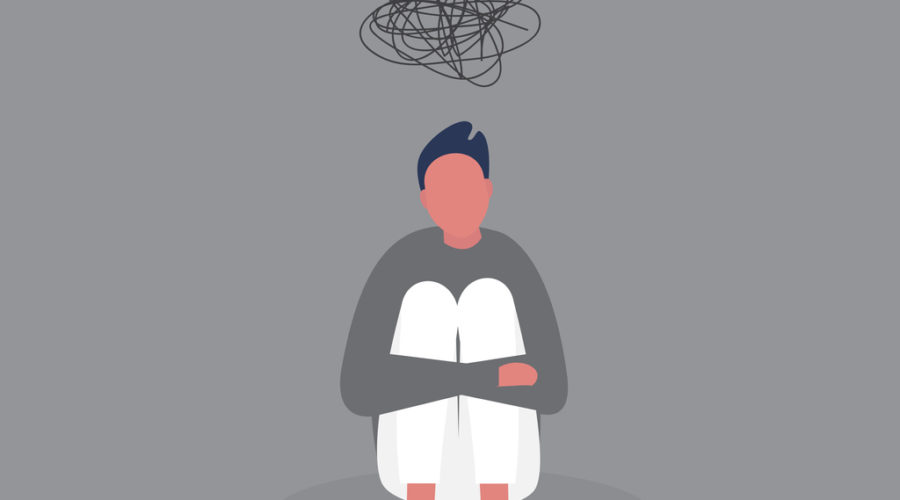Ketamine Experiences: What Happens If It Doesn’t Work?
I’d like to get this disclosure out of the way from the get-go: This ketamine experience is about a personal friend of mine, Devin. Devin has major depressive disorder (MDD), and, in late November 2021, he disclosed to me that he was suicidal.
What does a friend do in that situation? I was worried. Actually, more accurately, scared, for Devin.
Normally, I am the type of person who looks at a problem and comes up with a course of action to try and solve it, but in the face of a depression so deep that suicide was becoming the only option — I had no idea what to do.
The only thing stopping me from moving in with him and just watching him 24/7 was the fact that I knew he was in regular therapy and was actively speaking about these feelings with his therapist. So I sat, and I worried, and I thought. And after a couple of days, while working on an article about ketamine for alcohol use disorder, a little lightbulb went off in my head: What about ketamine?
RELATED: Where is Ketamine Telehealth Legal?
I knew there had been some promising clinical research looking at ketamine for depression, and specifically looking at suicidal crisis, so I looked it up. After feeling reasonably confident about what I had found, I shared my recommendation with Devin.
While I was expecting some kind of push back, I was instead met with curiosity. What I didn’t know at the time was that Devin had been suffering with treatment resistant MDD and ADHD for years, and he had tried many different therapeutic approaches and prescription drugs along the way, with varying levels of success and failure. “Things had finally gotten so bad that I was just kind of desperately looking for anything,” he said.
Devin, being the smart human that he is, did some research of his own. He also shared his interest in ketamine with his mother. “I told my mom about it, and she looked up a bunch of papers and soon started encouraging me to do it, too,” he remembered.
After a little more research into ketamine clinics in New York City, Devin had decided to actively pursue ketamine as an option. While his spirits were buoyed by a new prospect for relief, he couldn’t help but worry: “I’m in such a bad place — if this doesn’t work what else is left?”
Once he had settled on a clinic, they did a free screening call where they asked him a variety of questions about his medical history and he asked them a variety of questions about what ketamine therapy was and how it worked.
Devin remembers focusing on optimizing his chances for success. So he asked his doctor questions about what factors make it more likely to work, and what might inhibit the efficacy.
His doctor explained that some medications, like benzodiazepines, could dampen the effects of ketamine, and added that generally they encourage their patients to stay sober for the month so as to maximize the effects of the neuroplastic period that ketamine opens up. After hanging up, he had decided he would give ketamine a try.
RELATED: Is Ketamine Therapy For Depression Safe?
The Initial Ketamine Treatment Protocol
Devin worked with Ember Health, and his initial treatment protocol consisted of four “foundational sessions” that happened over the course of two weeks followed by maintenance sessions every six weeks.
When I asked Devin about how he felt going into his first session, he admitted that he was encouraged by the clinical studies on ketamine for depression (some of which having reported as high as an 85 percent success rate 24 hours after first infusion), but not without skepticism.
“Because I have treatment resistant depression and have tried everything, I was worried I would spend all this money and be in that 15 percent,” he said. “I was cautiously optimistic at best.”
Though the Ember location Devin visited is nestled inside an otherwise bland office building in Downtown Brooklyn, Devin appreciated the effort put in to make the clinic a welcoming and comfortable space with plants and pillows and comfortable seating. “Definite spa vibes,” as he put it.
He met with a doctor for 30 minutes before the first infusion to discuss his history in a bit more detail and to go over how the treatment session would go. He also asked a question that his doctor had clearly heard many times before: What is it going to feel like? “She told me: it doesn’t matter how many times I explain it to someone, it is always different than they expect,” he told me. “I don’t know what I was expecting, but it wasn’t what happened.”
The Ketamine Experience
Devin got settled into a chair in one of three infusion rooms. He remembers the chairs as being very comfortable (“A+ on the chairs”) and was offered four different aromatherapy blends to choose from. These scents were part of a bigger theme offered for the session — themes like “uplifting” or “grounded” for example — that also had a corresponding audio track to go with it.
His doctor explained that after he put on an eye mask and noise canceling headphones, they would touch his leg to let him know the infusion had started and sit there beside him throughout the session. If he chose to verbalize anything they would take notes.
And then? “I went on a journey of the mind.”
As his doctor had predicted, it was not anything like what he was expecting. “I had no experience with psychedelics,” he said. “I had taken mushrooms in very small doses so this whole thing was entirely new to me, and [the first session] was wonderful.”
Since I know Devin fairly well, I can confidently say he’s rarely at a loss for words — this person is a talker. But during his first session he remembers being so hesitant to verbalize his experience. “I was worried if I talked I would realize I wasn’t where I thought I was, and then I would break the spell.”
But soon enough there was so much going on in his ketamine journey that he didn’t want to forget it. Later, the nurse told him that about 60 percent of people don’t say anything and the rest do some talking. But Devin? He talked a lot.
And it turns out he’s glad he did. The notes that they shared with him after every session have offered additional insights and discoveries after he’s gone back to review them. These play an important part in his integration.
As an outsider looking in, it seems to me that Devin’s second session might have been his biggest in terms of healing. He describes each session as having a specific energy and aesthetic, with the first being a fun sci-fi-esque adventure. The second he described as gothic horror, “but not in a scary way.”
He found himself in a gothic ballroom, with tattered curtains and ghosts waltzing around him. “Out of nowhere I became overwhelmed by emotion, by sadness, and I started crying,” he remembered.
Soon a force, an entity, started breaking through the floor.
“It was a Lovecraftian god,” Devin remembered. Huge and towering and breaking out of the confines of the gothic ballroom, this god-like entity had the sheen and texture of jade but was a deep blue in color, and Devin remembers it as having a very stoic presence.
Then, a wave of realization: “This is my sadness, and it has grown so big and has pushed aside every other emotion inside me. I am afraid to release it or even to shrink it because I feel like it has become structural to who I am.”
And in this altered state, Devin’s reaction was one of hope and optimism. “I started thinking it doesn’t have to be that way, and that I need to do better,” he remembered. “Even if I fall apart, I have people who love me and will support me and help me rebuild — I think it’s time to figure out who Devin is without his sadness.”
I have a clear memory of speaking with Devin after that session, and, even though he describes that second experience as “very cathartic but very challenging,” the only word I can use to describe his mood as we talked is: light. As if an enormous weight had been lifted.
“For a very long time after that, I just did not feel sadness in the way I had.”
RELATED: Mike Wilson: Gaming’s Medicinal Madman
Devin’s Challenges With Ketamine Therapy
Overall, Devin describes his experience with ketamine therapy as positive. He even claims he is an ‘evangelist’ — but that does not mean the journey has been entirely easy.
Perhaps the biggest challenge is access: ketamine therapy is not only expensive, but insurance does not often cover it, either. With recent changes to his employment and a loss of insurance coverage, Devin hasn’t been able to continue maintenance sessions.
As of writing, it’s been almost three months since his second maintenance session.
“Now I am a little worried because clearly [the benefit] fades.” Even with a clinic like Ember, who works to help patients get as much insurance coverage as possible, the co-pay remains high. “It’s just too expensive,” was a refrain I heard again and again.
The second challenge Devin faced is around integration and support. Many ketamine clinics require that a patient be working with an accredited healthcare provider: psychiatrists, psychologists, therapists, or primary care providers. But, since the field is so young, most mental healthcare providers lack experience in how to support these types of experiences.
So while Devin was able to talk through the ketamine journeys with his regular therapist, there was no specialized support or integration service provided. This is true of many ketamine clinics: integration services are not part of the trip.
And this brings us to Devin’s bad trip. “That’s what the kids in the 60s called it, right,” he joked as we talked about it. It was his first maintenance session, and it went, well, badly. “I wanted to end it early because I was very anxious and uncomfortable,” he remembered. “Afterwards I felt almost worse.”
He was able to talk about it with Ember’s attending doctor. This was after the fact, however, and he received ample support from their team. But it’s worth pointing out that challenging experiences can, and do, happen. It’s also worth pointing out that ketamine has a very good safety profile.
Devin had also started a new ADHD drug called Strattera, which he speculated could have been the problem. This is because he stopped the medication due to side effects, and the subsequent ketamine maintenance session was fine.
Regardless, challenging or bad trips, while not dangerous, can be unpleasant. They can also be meaningful and profound, providing opportunities for growth.
Thanks to the session notes Ember took, and his own strong need to process after the fact (and I will point out supported by years of practice in his own therapy sessions), Devin feels like he has been able to do good integration work. He expressed gratitude for the personal level of care he got, and the clinic’s regular check-ins to make sure he’s doing well, “but I think there they could be doing more in the way of integration.”
Devin also suggested a group talk session or a meetup where patients could discuss their ketamine experiences. He talked about more support around how to best make use of the neuroplasticity that ketamine induces. “Things like guided meditations maybe, or a workbook. I wish there was a little more of that.”
And, finally, the least easy to pick apart of Devin’s challenges. “And something I worry might be a danger,” he added.
In several of his sessions, Devin experienced a feeling of having access to knowledge and understanding that wasn’t available in his ordinary states of consciousness. “It definitely felt like, at times, like I was in touch with a greater truth, with a divine presence,” he explained.
He experienced what felt like fundamental truths about reality and our purpose as humans. Feelings of interconnectedness and unity, which typical of the mystical experiences from psychedelics. “It just felt so real,” he remembered.
On more than one occasion, he felt that he was on the verge of a major revelation around his own life purpose or a solution to his personal challenges. But, just as that answer was about to be come — poof! The infusion was over.
He likened the experience to the Greek myth of Tantalus, a wicked king who had tricked the Gods one too many times. As punishment, Tantalus was made to stand in a pool of water, under a heavily fruit-laden branch of tree. Whenever Tantalus would crouch down to drink, the water would recede. Whenever he would attempt to get fruit from the branch, it would move out of his reach.
The myth of Tantalus is where we get the word “tantalizing,” and while we often use this word in a positive way (“ooh that food is tantalizing”), when you know the origin of this word you can see it’s an adjective that has an edge. “So I feel like ketamine might be tantalizing,” explained Devin.
Devin’s observation touches upon some interesting ongoing questions around ketamine therapies, because when I hear that ketamine is ‘tantalizing’ I can’t help but think about the potential for dependency and abuse: Ketamine is not without risk. However, many believe that risk is less when used in a clinical setting under the supervision of a physician.
Interestingly, ketamine is also being investigated to treat substance use disorders, so I mention this only to highlight the many nuances of these treatments that we have yet to uncover with clinical research.
Final Reflections About Devin’s Ketamine Experience
When Devin first started ketamine treatment, he imagined he would look back on this point in time forty years from now and see it as a major turning point.
Now, in the face of ongoing challenges and a loss of access to treatment, his hopes have dropped a little. “My realization that it is very helpful but it’s not a magic bullet,” he said.
And this is a realization that bears underscoring.
Since, in the age of a psychedelics hype bubble when these medicines are often touted as “cures”, many people have unrealistic expectations as to what the healing process with psychedelics is really like.
When the foundational ketamine sessions ended, Devin had to get back to regular life. “I had to live in the real world for six weeks. All my problems hadn’t all magically gone away and I still had many issues to deal with,” he said. The ketamine treatments just made it easier.
“I still need to go from point A to point B, and there is still the effort needed to go down that road,” he explained. “But it’s like there was a snow plow that cleared the road. You still need to do the work but there are fewer obstacles, and that in and of itself is huge.”
Even with access to therapy cut off and the effects starting to fade, Devin is grateful for his opportunity to work with ketamine.
“Certainly from where I was before I started, in an extremely depressive state, it may have saved my life,” he said. “It really had an amazing impact. It didn’t fix everything in my life, but it was an amazing turn around in a short period of time.”



